Isaac Newton Manuscript
November 29, 2011
Description by Craig Bruce Smith, Archives and Special Collections Assistant and PhD candidate in History
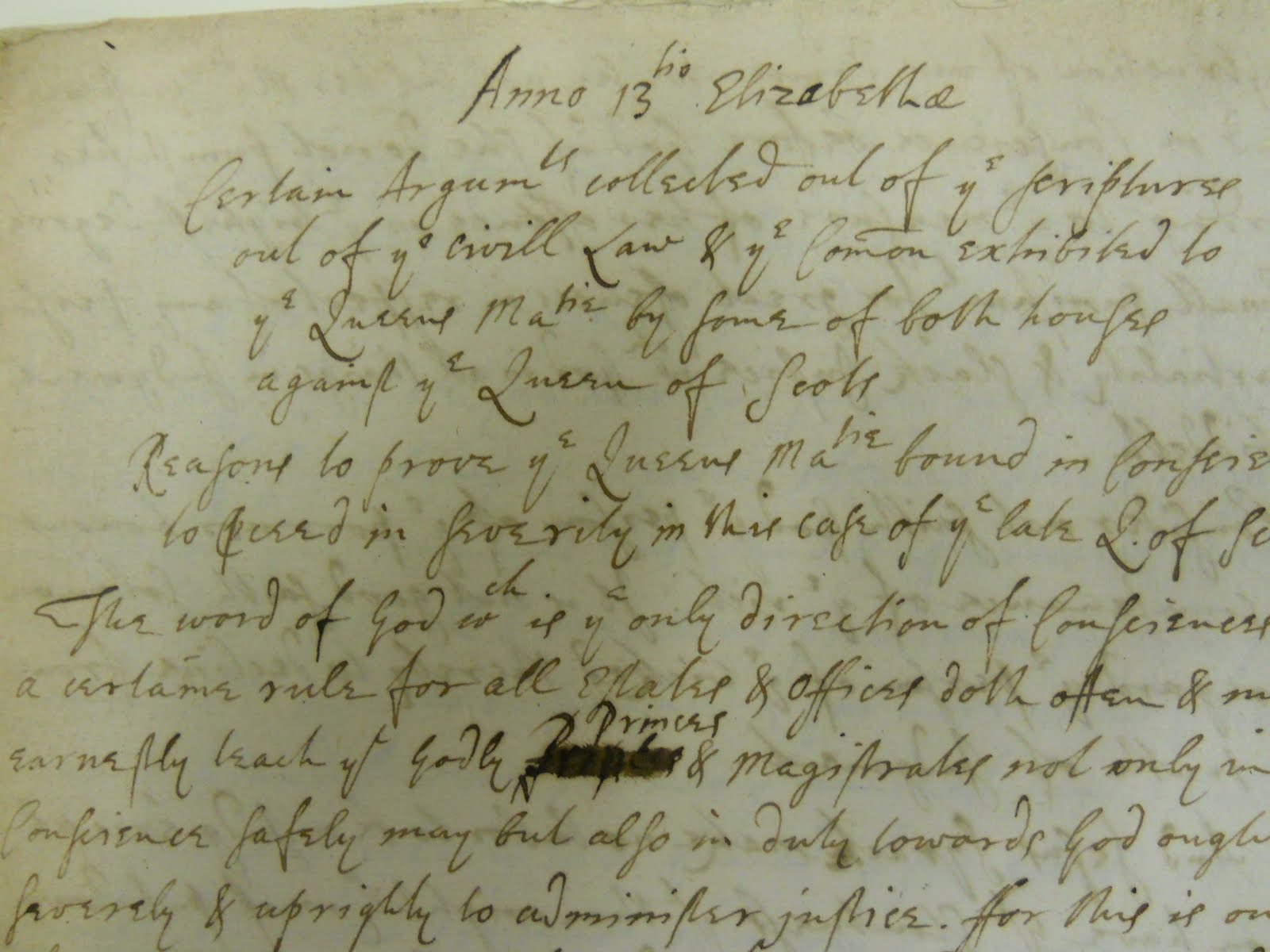 Brandeis University’s Robert D. Farber University Archives and Special Collections Department possesses an exceptionally rare unpublished handwritten manuscript by Sir Isaac Newton. The manuscript, a gift of Philip D. Sang, is entitled “Certain Arguments collected out of ye Scriptures, out of ye Civill[sic] Law & ye Common exhibited to ye Queen Majesty by some or both houses against ye Queen of Scots,” and is a historical editorial that justifies the execution of Mary Stuart (also known as Mary, Queen of Scots), by her cousin, Queen Elizabeth of England, in 1587.[1] Although it was likely composed in London during the late 17th century, nearly a century after Mary was beheaded, Newton’s manuscript establishes a precedent for killing a monarch based on principles of justice detailed throughout the Bible and history. At first glance, this manuscript provides an intriguing view into the lesser publicized thoughts of one of history’s greatest thinkers, as well as presenting a rather unsympathetic view that capital punishment was a necessity of religious observance and devotion. But upon further inspection, the possibility exists that this manuscript was a concealed example of Newton’s political dissent.
Brandeis University’s Robert D. Farber University Archives and Special Collections Department possesses an exceptionally rare unpublished handwritten manuscript by Sir Isaac Newton. The manuscript, a gift of Philip D. Sang, is entitled “Certain Arguments collected out of ye Scriptures, out of ye Civill[sic] Law & ye Common exhibited to ye Queen Majesty by some or both houses against ye Queen of Scots,” and is a historical editorial that justifies the execution of Mary Stuart (also known as Mary, Queen of Scots), by her cousin, Queen Elizabeth of England, in 1587.[1] Although it was likely composed in London during the late 17th century, nearly a century after Mary was beheaded, Newton’s manuscript establishes a precedent for killing a monarch based on principles of justice detailed throughout the Bible and history. At first glance, this manuscript provides an intriguing view into the lesser publicized thoughts of one of history’s greatest thinkers, as well as presenting a rather unsympathetic view that capital punishment was a necessity of religious observance and devotion. But upon further inspection, the possibility exists that this manuscript was a concealed example of Newton’s political dissent.
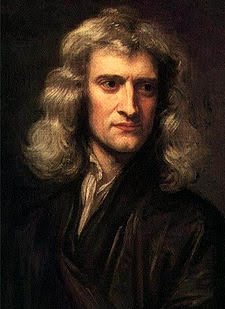 Isaac Newton was born on December 25, 1642, outside of Colsterworth, England, into a family “wholly without distinction and wholly without learning.”[2] Before his death, in 1727, Newton would be educated at Cambridge University, be knighted by Queen Anne and become universally recognized as one of the key driving forces of the Enlightenment. Famed as a physicist and mathematician, Newton nevertheless wrote on a number of diverse subjects, including history and religion. The contents of this manuscript are not widely known and are open to reinterpretation, as they are absent from printed and digitized versions of Newton’s unpublished papers and virtually undocumented among historical and other secondary works, for reasons that remain unclear.
Isaac Newton was born on December 25, 1642, outside of Colsterworth, England, into a family “wholly without distinction and wholly without learning.”[2] Before his death, in 1727, Newton would be educated at Cambridge University, be knighted by Queen Anne and become universally recognized as one of the key driving forces of the Enlightenment. Famed as a physicist and mathematician, Newton nevertheless wrote on a number of diverse subjects, including history and religion. The contents of this manuscript are not widely known and are open to reinterpretation, as they are absent from printed and digitized versions of Newton’s unpublished papers and virtually undocumented among historical and other secondary works, for reasons that remain unclear.
Newton’s manuscript, numbering eleven pages and roughly three thousand words, is composed in a bold and distinctive (often nearly illegible) calligraphic script (Newton historian Stephen Snobelen has recently preliminarily determined the manuscript to be in the hand of Sir Isaac's personal scribe, the unrelated Humphrey Newton) and acts as a call to all Christian monarchs to levy justice consistent with the will of God. Newton declares, “Every good Prince ought by Gods commandment to punish even by death all such as do seek to seduce the people of God from his true worship.”[3] The document is framed around the case of Mary Stuart, who was tried and convicted for plotting to seize the throne from Elizabeth with the assistance of Catholic soldiers. Newton supports her execution (and those of any erring monarch) on the basis of Biblical citations, primarily from the Old Testament.[4]
The tone and language of the manuscript are thoroughly uncompromising. Newton warns, “When God by his just providence doth commit any grevious[sic] offenses into ye hands of a Prince or Magistrate as to his minister to be punished he ought to fear ye heavy displeasure of God if by any color he do omitt[sic] ye same.”[5] The text admonished anyone who displays “slackness” in the administration of justice, and is equally dismissive of “mercy” and “pity” as misguided and dangerous.[6] Newton points to the Book of Samuel, among others, to prove his position: “When Saul spared Agag although he ware[sic] a King [of the Amalekites] God took from ye same Saul his good Spirit & transferred ye Kingdom of Israel from him & his heirs forever.”[7] Newton draws this parallel to justify Queen Elizabeth’s execution order and sets the stakes if she failed to complete it: “if she [Mary Stuart] escape with no slight or punishment her majesty in Conscience ought as also good & faithful subjects to fear ye God will reserve her as on Judgment to put her from ye royall[sic] seal of this Kingdom & too plague the unthankfull[sic] & naughty subjects.”[8]
One of the more interesting and seemingly un-Enlightened advancements by Newton in this manuscript was his supposition that “God often times bringeth Sinners to punishment for other offenses then those yet are known & appear to ye world.”[9] Thus, kings and queens as God’s judges on Earth must account for all the faults of the accused, both known and unknown, weighing a tangible and an invisible world, and are thereby to be discouraged from clemency, as he suggests that divine providence has brought these individuals before justice.
By far the most tantalizing aspect of this manuscript is its date, which could potentially yield immensely intriguing results for future researchers. Nominally the manuscript is presented as a justification for Queen Elizabeth’s execution of Mary Stuart. The tone and commentary of the piece seek to prove a case in Elizabeth’s favor. But why was such rhetoric necessary roughly one hundred years after Mary’s neck met an axe? Could this document’s message have been aimed at a more contemporary cause?
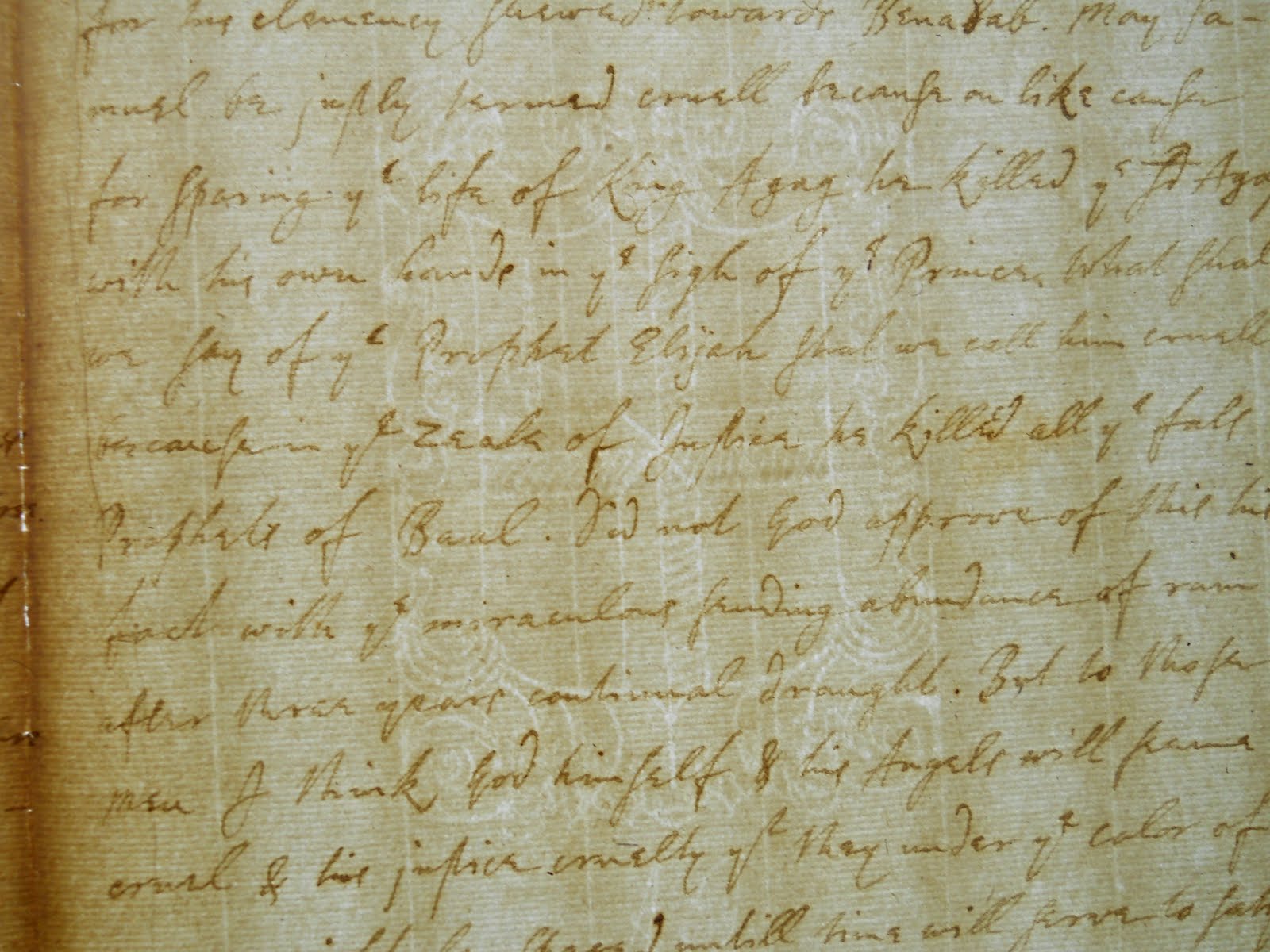 The first clue lies in the watermark of the coat of arms of the City of London, which is prominently displayed on several pages. This particular crest was used from approximately 1683–1710, thus the reason that Brandeis University initially dated the document at circa 1685 when it acquired it in 1961.[10] Based on this preliminary dating, combined with an examination of the manuscript’s themes, Newton’s life and English history, it is possible that “Certain Arguments” was written in support of and/or justification for the sentiments of the Glorious Revolution of 1688, which deposed King James II.
The first clue lies in the watermark of the coat of arms of the City of London, which is prominently displayed on several pages. This particular crest was used from approximately 1683–1710, thus the reason that Brandeis University initially dated the document at circa 1685 when it acquired it in 1961.[10] Based on this preliminary dating, combined with an examination of the manuscript’s themes, Newton’s life and English history, it is possible that “Certain Arguments” was written in support of and/or justification for the sentiments of the Glorious Revolution of 1688, which deposed King James II.
As the turmoil surrounding the succession of a fervently Catholic King James II in largely Protestant England after the death of King Charles II in 1685 escalated, Newton was hard at work authoring his Principa, which outlined the laws of motion and gravity. Biographer Richard Westfall contends that “During the following two years, the Principa absorbed Newton’s consciousness so completely that it excluded everything else.”[11] In this respect, one could assert that it would have been unlikely for Newton to be engaged in a side project, such as “Certain Arguments,” that so fundamentally differed from his obsessive work on the Principa. Thus it seems unlikely that the manuscript was crafted before 1687.
That same year, James II attempted to turn the universities, longtime havens of Anglican strength, into Catholic tools. As such, Newton became mired in the clash between Catholicism and Anglicanism, as the king ordered the appointment of Alban Francis, a Benedictine monk, into Cambridge University without taking the traditional oath of loyalty to the Church of England. In a tone extremely reminiscent of “Certain Arguments,” Newton daringly wrote, “For all honest men are obliged by the Laws of God & Man to obey the King’s lawfull Commands. But if his Majesty be advised to require a matter wch cannot be done by Law, no Man can suffer neglect for it.”[12] Newton’s words in opposition to the King’s appointment echo his thoughts that even monarchs must face justice for “seduc[ing] the people of God from his true worship unto Superstition and Idolatry.”[13] Biographer Frank Manuel (a former member of the Brandeis History faculty) states that Newton regarded “the contemporary papists and their antecedents the pagan idolaters” as “the corrupters of religion.”[14] Newton said of Mary Stuart, a Catholic and ancestor of James II, that she “hath not only sought & wrought by all means she can to seduce ye people of God in this realm from true religion.”[15] Newton even went so far as to allude to a similar warning given to her son, King James I. [16]
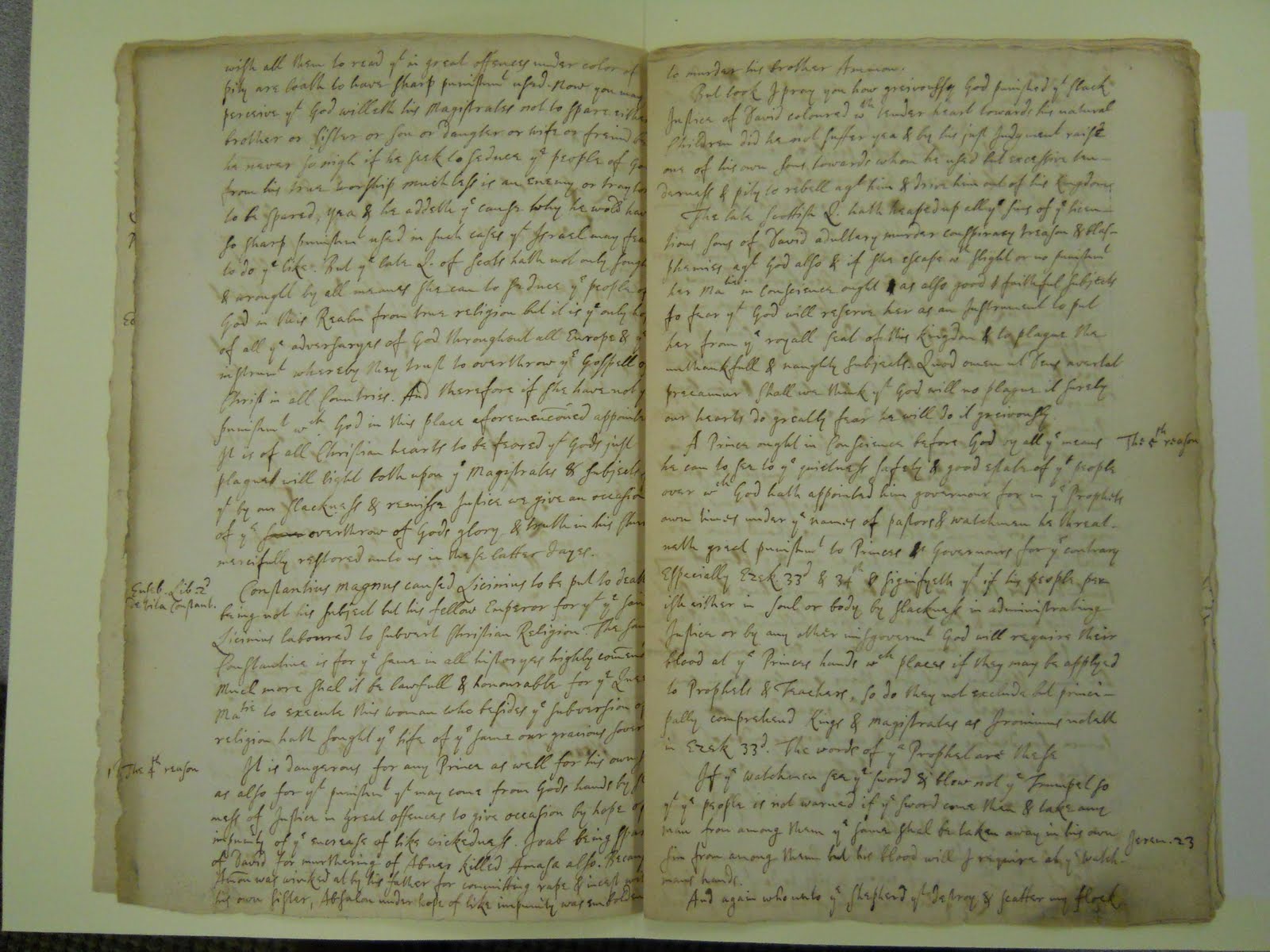 The accusations against the Stuart family are unmistakable, but the question remains: is this particular manuscript aimed at James II as well? Westfall professes that by 1687, “In the view of leaders of the opposition to James, Newton had joined their ranks. He had good cause to lie low until the revolution.”[17] This states that Newton, at least in principle, was opposed to the reign of James II; it also suggests that the manuscript would likely have been authored “once the revolution had ratified [his] courage.”[18] This circumstantial evidence would seem to set its date of origin as 1688 or later if it is indeed an anti-James text, but this is by no means definitive. In fact, a catalog of the Newton papers published by Cambridge University in the late 19th century included the manuscript in a list of “papers on various historical subjects, chiefly of the reign of James II, relating to the Father Francis business.”[19] Based on Cambridge’s inquiry into Newton’s writings, it seems likely that “Certain Arguments” was directly related to the coming, rather than the aftermath, of the Glorious Revolution.
The accusations against the Stuart family are unmistakable, but the question remains: is this particular manuscript aimed at James II as well? Westfall professes that by 1687, “In the view of leaders of the opposition to James, Newton had joined their ranks. He had good cause to lie low until the revolution.”[17] This states that Newton, at least in principle, was opposed to the reign of James II; it also suggests that the manuscript would likely have been authored “once the revolution had ratified [his] courage.”[18] This circumstantial evidence would seem to set its date of origin as 1688 or later if it is indeed an anti-James text, but this is by no means definitive. In fact, a catalog of the Newton papers published by Cambridge University in the late 19th century included the manuscript in a list of “papers on various historical subjects, chiefly of the reign of James II, relating to the Father Francis business.”[19] Based on Cambridge’s inquiry into Newton’s writings, it seems likely that “Certain Arguments” was directly related to the coming, rather than the aftermath, of the Glorious Revolution.
Newton was an anti-papist who regarded the Catholic Church as indicative of “the reign of Antichrist,” and his support of the Protestant monarchs William and Mary is consistent with a reading of the manuscript as an anti-Catholic and anti-James text.[20] The claim that a covert subtext exists in Newton’s historical writings is not novel. Speaking of Newton’s The Chronology of Ancient Kingdoms, Manuel wrote, “There is real passion in Newton’s denunciation of ancient kings who through imposture foisted a false worship upon their peoples and enticed them away from primitive monotheism. His argument sounds as if he were excoriating some contemporary royal court. The vehemence may hark back to the attempt of James II to insinuate Catholicism among his subjects.”[21] The exception results from the fact that Manuel was speaking on what appears to be a reflective work, as it was written later in Newton’s life and only published posthumously in 1728 (although earlier versions, known as “Origines,” existed in the 1690s and drafts date to the 1720s); Brandeis’ manuscript may be the earliest example of Newton’s anti-James sentiments, as it could pre-date the Revolution.[22] The fact remains that the manuscript could have been written after the Revolution, during a similar time frame as Newton’s “Origines,” and represent another example of the older Newton’s historical and religious interests. However, it seems doubtful that the relatively recent history of “Certain Arguments” would fit within the context of the ancient kingdoms of Newton’s Chronology, and as such one could assume that its creation must predate it. Based on the available source material, it seems that “Certain Arguments” was written in 1687 and represents Newton’s support for events that would transpire within the next year.
In addition, the manuscript’s history is in many ways just as interesting as its contents. It was originally part of Newton’s unpublished manuscripts that were long hidden from public view, largely because of the prominence of alchemical research deemed heretical. Many of these papers were regarded as far too radical and potentially dangerous to publish. After Newton’s death, the papers passed into the hands of his nephew-in-law and friend, John Conduitt (married to Catherine Barton, Newton’s half-niece), and down through their line. As the Conduitts’ only child married Lord Lymington of the Portsmouth family, the papers became known as the Portsmouth Collection. The first cataloging of the entire collection took place only in 1888, and represents one of the few documented appearances of this manuscript in any written record.[23] While Newton’s scientific papers were privately donated to Cambridge University, the remainder of his writings survived a fire at the family’s home of Hurstbourne Park before receiving a more public sendoff.[24]
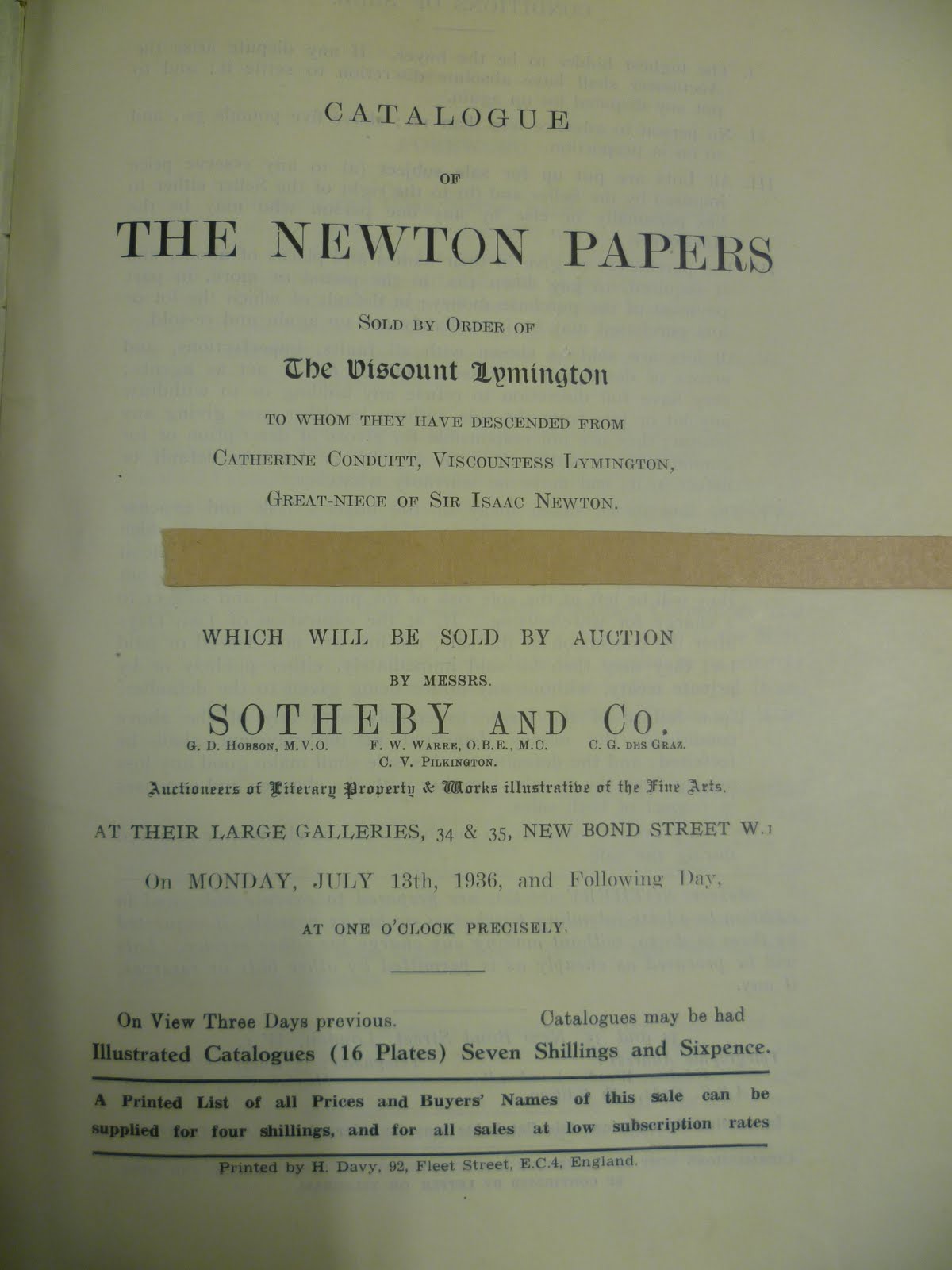 In July 1936, the Viscount Lymington, Gerard Vernon Wallop, a former Conservative Member of Parliament and the son of the 8th Earl of Portsmouth, put the remaining manuscripts up for auction at Sotheby’s in London for “various reasons,” including mounting family debt.[25] However, thanks to the Great Depression and a competing fine art sale, the auction did not generate a great deal of income for Lymington—this particular manuscript, Lot 287, was sold to W. Manning for an extremely modest £8.10s, while the entire sale generated only a “miserly sum of just over £9,000.”[26] The true value of the Sotheby’s auction would not be felt until years later, when the dissemination of the collection’s contents made its way into the scholarly literature and illuminated a previously unknown chapter of Newton’s life.
In July 1936, the Viscount Lymington, Gerard Vernon Wallop, a former Conservative Member of Parliament and the son of the 8th Earl of Portsmouth, put the remaining manuscripts up for auction at Sotheby’s in London for “various reasons,” including mounting family debt.[25] However, thanks to the Great Depression and a competing fine art sale, the auction did not generate a great deal of income for Lymington—this particular manuscript, Lot 287, was sold to W. Manning for an extremely modest £8.10s, while the entire sale generated only a “miserly sum of just over £9,000.”[26] The true value of the Sotheby’s auction would not be felt until years later, when the dissemination of the collection’s contents made its way into the scholarly literature and illuminated a previously unknown chapter of Newton’s life.
The bulk of the Newton collection auctioned by Sotheby’s was purchased by two individuals: Lord John Maynard Keynes, a noted economist, and Abraham Yahuda, a prominent businessman. Keynes largely focused on obtaining Newton’s alchemical papers, while Yahuda opted for his theological writings. Their collections were later donated to Cambridge University and the Jewish National and University Library respectively.[27]) Brandeis’ manuscript was one that both gentlemen were unable to acquire; instead, as Keynes recalled, it was likely “snatched out of my reach by a syndicate which hoped to sell [it] at a high price, probably in America.”[28] It is unclear what type of journey “Certain Arguments” made after the auction, as its original purchaser, W. Manning, is one of the few elusive bidders who remain unidentified; some of his lots (along with those of another mysterious buyer, Mr. May) “remain unlocated to this day.”[29]
Ultimately the manuscript did cross the Atlantic, as it was acquired by Philip D. Sang, a generous Brandeis benefactor, in the early 1960s and subsequently donated to Brandeis University, where it currently resides.[30] “Certain Arguments” is an extremely important historical piece, as it presents the possibility of further research on Newton’s political sentiments on the eve of the Glorious Revolution, as well as opens up new avenues to analyze the life of this prominent figure. While the manuscript itself may not be in the hand of Newton, this does not dismiss the importance of the document, as it seems to be a highly original interpretation arising from Newton's mind and recorded by an alternate hand
Finding aid to Autograph Collection
Notes
- Isaac Newton. “Certain Arguments…,” Autograph collection, Robert D. Farber University Archives & Special Collections, Brandeis University; “Isaac Newton Manuscript” (description accompanying manuscript), ibid.
- Richard S. Westfall. Never at Rest: A Biography of Isaac Newton. Cambridge: Cambridge University Press, 1980, p. 40.
- Newton, “Certain Arguments…”
- Ibid; For more on Newton and Judaism: Matt Goldish. Judaism in the Theology of Sir Isaac Newton. Dordrecht, Netherlands: Kluwer Academic Publishers, 1998.
- Newton, “Certain Arguments…”
- Ibid.
- Newton, “Certain Arguments…”; 1 Samuel 15.
- Newton, “Certain Arguments…”
- Ibid.
- “Isaac Newton Manuscript,” Brandeis University.
- Westfall, p. 473.
- Frank E. Manuel. A Portrait of Isaac Newton. Cambridge, MA: Harvard University Press, 1968, p. 110-111.
- Newton, “Certain Arguments…”
- Frank E. Manuel. The Religion of Isaac Newton: The Fremantle Lectures 1973. Oxford: Clarendon Press, 1974, p. 65
- Newton, “Certain Arguments…”
- Ibid.
- Westfall, p. 480.
- Ibid.
- A Catalogue of the Portsmouth Collection of Books and Papers Written by or Belonging to Sir Isaac Newton. Cambridge: Cambridge University Press, 1888, p. 26.
- Frank E. Manuel. The Religion of Isaac Newton, p. 65, 67; Westfall, p. 487.
- Frank E. Manuel. Isaac Newton, Historian. Cambridge: Harvard University Press, 1963, p. 115-116.
- Westfall, p. 805, 814; Humphrey Newton was employed by Newton from approximately 1683 to 1688, thus adding greater evidence to the claimed date. Stephen Snobelen, e-mail message to author, 6 Jun. 2011.
- A Catalogue of the Portsmouth Collection.
- P. E. Spargo. “Sotheby’s, Keynes and Yahuda – The 1936 Sale of Newton’s Manuscripts,” The Investigation of Difficult Things: Essays on Newton and the History of Exact Sciences. Cambridge: Cambridge University Press, 1992, p. 116.
- “The Sotheby Sale,” The Newton Project; Spargo, p. 116.
- Sarah Colville (Sotheby’s), e-mail message to author, April 15, 2011; “The Sotheby Sale,” The Newton Project.
- “The Sotheby Sale,” The Newton Project.
- John Maynard Keynes. “Newton the Man,” The Newton Project.
- Spargo, p. 120.
- Louis Schreiber to David S. Berkowitz, 1 Mar. 1961, Brandeis University.